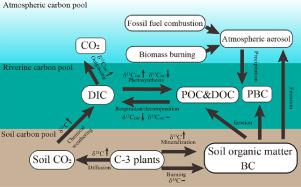Water Research ( IF 11.4 ) Pub Date : 2021-02-14 , DOI: 10.1016/j.watres.2021.116932 Jinke Liu , Guilin Han

|
Rivers transport abundant terrestrial carbon into the ocean, constituting a fundamental channel between terrestrial carbon pools and oceanic carbon pools. The black carbon (BC) derived from biomass and fossil fuel combustion is an important component of the riverine organic carbon flux. A recent study estimated that approximately 17 ~ 37 Tg C of BC was delivered in suspended particle phase by rivers per year. The particulate black carbon (PBC) in river systems has rarely been investigated and its controlling factors have remained largely unknown. The stable isotopic compositions of PBC in Xijiang River during the wet season are reported in this study. We found that the PBC/particulate organic carbon (POC) ratio in Xijiang River was slightly higher than that of other rivers, which may be a result of the mobility difference between POC and PBC, aerosol BC input and riverine biogenic effect. We found that the isotopic compositions of PBC depleted 13C compared with those of POC and dissolved organic carbon (DOC). This divergence may be derived from the fractionation during soil organic matter production and biomass burning or fossil fuel combustion BC particles input with different isotopic compositions. The MixSIAR model indicated that most of the PBC in the study area was derived from fossil fuel combustion (~80%), the contribution of C4 plants burning was limited. Our result highlights that in the watershed without wildfire impact, the aeolian transport and deposition of the particles from fuel oil, coal combustion, and vehicle exhaust could significantly affect the BC flux in rivers.
中文翻译:

追踪西江流域河流颗粒状黑碳源:稳定同位素组成和贝叶斯混合模型的启示
河流将大量的陆地碳输送到海洋中,构成了陆地碳库和海洋碳库之间的基本通道。来自生物质和化石燃料燃烧的黑碳(BC)是河流有机碳通量的重要组成部分。最近的一项研究估计,河流每年以悬浮颗粒相的形式输送约17〜37 Tg C的BC。很少对河流系统中的颗粒黑碳(PBC)进行调查,其控制因素仍然未知。本研究报道了西江干流在雨季的稳定同位素组成。我们发现西江的PBC /颗粒有机碳(POC)比其他河流略高,这可能是由于POC和PBC之间的迁移率差异所致,BC气溶胶输入和河流生物成因。我们发现PBC的同位素组成已耗尽13下用这些POC的和溶解的有机碳(DOC)进行比较。这种差异可能源于土壤有机质生产和生物质燃烧或化石燃料燃烧BC粒子输入过程中的同位素分馏,其中BC粒子的同位素组成不同。MixSIAR模型表明,研究区域的大部分PBC来自化石燃料燃烧(约80%),C4植物燃烧的贡献有限。我们的结果表明,在没有野火影响的流域中,来自燃油,煤炭燃烧和汽车尾气的风沙运输和颗粒物沉积会显着影响河流中的BC通量。











































 京公网安备 11010802027423号
京公网安备 11010802027423号